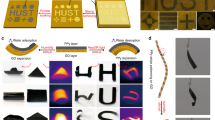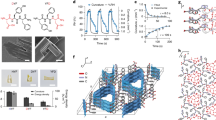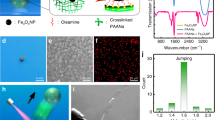Abstract
Devices that respond to negligibly small fluctuations in environmental conditions will be of great value for the realization of more sustainable, low-power-consumption actuators and electronic systems. Herein we report an unprecedented film actuator that seemingly operates autonomously, because it responds to the adsorption and desorption of a minute amount of water (several hundred nanograms per 10 mm2) possibly induced by fluctuations in the ambient humidity. The actuation is extremely rapid (50 ms for one curl) and can be repeated >10,000 times without deterioration. On heating or light irradiation, the film loses adsorbed water and bends quickly, so that it can jump vertically up to 10 mm from a surface or hit a glass bead. The film consists of a π-stacked carbon nitride polymer1, formed by one-pot vapour-deposition polymerization of guanidinium carbonate, and is characterized by a tough, ultralightweight and highly anisotropic layered structure. An actuator partially protected against water adsorption is also shown to walk unidirectionally.
This is a preview of subscription content, access via your institution
Access options
Subscribe to this journal
Receive 12 print issues and online access
$259.00 per year
only $21.58 per issue
Buy this article
- Purchase on Springer Link
- Instant access to full article PDF
Prices may be subject to local taxes which are calculated during checkout





Similar content being viewed by others
References
Kroke, E. gt-C3N4—the first stable binary carbon(IV) nitride. Angew. Chem. Int. Ed. 53, 11134–11136 (2014).
Hannan, M. A., Mutashar, S., Samad, S. A. & Hussain, A. Energy harvesting for the implantable biomedical devices: issues and challenges. Biomed. Eng. Online 13, 79 (2014).
Wang, J. & Zhang, W.-D. Modification of TiO2 nanorod arrays by graphite-like C3N4 with high visible light photoelectrochemical activity. Electrochim. Acta 71, 10–16 (2012).
Zhang, Y. et al. Protic salts of high nitrogen content as versatile precursors for graphitic carbon nitride: anion effect on the structure, properties, and photocatalytic activity. ChemPlusChem 80, 1139–1147 (2015).
Bian, J. et al. Thermal vapor condensation of uniform graphitic carbon nitride films with remarkable photocurrent density for photoelectrochemical applications. Nano Energy 15, 353–361 (2015).
Algara-Siller, G. et al. Triazine-based, graphitic carbon nitride: a two-dimensional semiconductor. Angew. Chem. Int. Ed. 53, 7450–7455 (2014).
Thomas, A. et al. Graphitic carbon nitride materials: variation of structure and morphology and their use as metal-free catalysts. J. Mater. Chem. 18, 4893–4908 (2008).
Jorge, A. B. et al. H2 and O2 evolution from water half-splitting reactions by graphitic carbon nitride materials. J. Phys. Chem. C 117, 7178–7185 (2013).
Dante, R. C., Martin-Ramos, P., Correa-Guimaraes, A. & Martin-Gil, J. Synthesis of graphitic carbon nitride by reaction of melamine and uric acid. Mater. Chem. Phys. 130, 1094–1102 (2011).
Oyen, M. L. & Cook, R. F. Load–displacement behavior during sharp indentation of viscous–elastic–plastic materials. J. Mater. Res. 18, 139–150 (2003).
Yang, M. et al. Dispersions of aramid nanofibers: a new nanoscale building block. ACS Nano 5, 6945–6954 (2011).
Ma, M., Guo, L., Anderson, D. G. & Langer, R. S. Bio-inspired polymer composite actuator and generator driven by water gradients. Science 339, 186–189 (2013).
Chen, X., Mahadevan, L., Driks, A. & Sahin, O. Bacillus spores as building blocks for stimuli-responsive materials and nanogenerators. Nature Nanotech. 9, 137–141 (2014).
Mu, J. et al. A multi-responsive water-driven actuator with instant and powerful performance for versatile applications. Sci. Rep. 5, 9503 (2015).
Cheng, H. et al. Moisture-activated torsional graphene-fiber motor. Adv. Mater. 26, 2909–2913 (2014).
Seki, T., Sakurada, K., Muromoto, M. & Ito, H. Photoinduced single-crystal-to-single-crystal phase transition and photosalient effect of a gold(I) isocyanide complex with shortening of intermolecular aurophilic bonds. Chem. Sci. 6, 1491–1497 (2015).
Medishetty, R. et al. Single crystals popping under UV light: a photosalient effect triggered by a [2 + 2] cycloaddition reaction. Angew. Chem. Int. Ed. 53, 5907–5911 (2014).
Zhang, L., Liang, H., Jacob, J. & Naumov, P. Photogated humidity-driven motility. Nature Commun. 6, 7429 (2015).
Kobatake, S., Takami, S., Muto, H., Ishikawa, T. & Irie, M. Rapid and reversible shape changes of molecular crystals on photoirradiation. Nature 446, 778–781 (2007).
Barrett, C. J., Mamiya, J., Yagerc, K. G. & Ikeda, T. Photo-mechanical effects in azobenzene-containing soft materials. Soft Matter 3, 1249–1261 (2007).
Iamsaard, S. et al. Conversion of light into macroscopic helical motion. Nature Chem. 6, 229–235 (2014).
Hosono, N. et al. Large-area three-dimensional molecular ordering of a polymer brush by one-step processing. Science 330, 808–811 (2010).
Wang, E., Desai, M. S. & Lee, S.-W. Light-controlled graphene-elastin composite hydrogel actuators. Nano Lett. 13, 2826–2830 (2013).
Zhang, X. et al. Photoactuators and motors based on carbon nanotubes with selective chirality distributions. Nature Commun. 5, 2983 (2014).
Zhao, Q. et al. An instant multi-responsive porous polymer actuator driven by solvent molecule sorption. Nature Commun. 5, 4293 (2014).
Erb, R. M., Sander, J. S., Grisch, R. & Studart, A. R. Self-shaping composites with programmable bioinspired microstructures. Nature Commun. 4, 1712 (2013).
Khan, M. K., Hamad, W. Y. & MacLachlan, M. J. Tunable mesoporous bilayer photonic resins with chiral nematic structures and actuator properties. Adv. Mater. 26, 2323–2328 (2014).
de Haan, L. T., Verjans, J. M. N., Broer, D. J., Bastiaansen, C. W. M. & Schenning, A. P. H. J. Humidity-responsive liquid crystalline polymer actuators with an asymmetry in the molecular trigger that bend, fold, and curl. J. Am. Chem. Soc. 136, 10585–10588 (2014).
Makowski, S. J., Köstler, P. & Schnick, W. Formation of a hydrogen-bonded heptazine framework by self-assembly of melem into a hexagonal channel structure. Chem. Eur. J. 18, 3248–3257 (2012).
Wu, C. et al. Large-area graphene realizing ultrasensitive photothermal actuator with high transparency: new prototype robotic motions under infrared-light stimuli. J. Mater. Chem. 21, 18584–18591 (2011).
Kohlmeyer, R. R. & Chen, J. Wavelength-selective, IR light-driven hinges based on liquid crystalline elastomer composites. Angew. Chem. Int. Ed. 52, 9234–9237 (2013).
Osada, Y., Okuzaki, H. & Hori, H. A polymer gel with electrically driven motility. Nature 355, 242–244 (1992).
Yamada, M. et al. Photomobile polymer materials—various three-dimensional movements. J. Mater. Chem. 19, 60–62 (2009).
Acknowledgements
We acknowledge E. Silver for generous discussion. This work was financially supported by a Grant-in-Aid for Specially Promoted Research (25000005) on ‘Physically Perturbed Assembly for Tailoring High-Performance Soft Materials with Controlled Macroscopic Structural Anisotropy’ together with the ImPACT Program of the Council for Science, Technology and Innovation (Cabinet Office, Government of Japan). We also acknowledge Scientaomicron for the nanoindentation measurement. D.M. is grateful for a Grant-in-Aid for Challenging Exploratory Research (Grant 15K13776) and Young Scientist A (Grant 15H05487).
Author information
Authors and Affiliations
Contributions
H.A. designed and performed all experiments. D.M. and T.A. co-designed the experiments. K.A., F.A., E.S., T.H. and M.K. conducted or supported the experiments for characterization. H.A., D.M. and T.A. analysed the data and wrote the manuscript.
Corresponding authors
Ethics declarations
Competing interests
A patent application (provisional patent number PCT/JP2013/084543) has been filed by RIKEN under the title ‘g-C3N4 film production method, and use of said film’.
Supplementary information
Supplementary Information
Supplementary information (PDF 5255 kb)
Supplementary Movie 1
Supplementary Movie 1 (MOV 12405 kb)
Supplementary Movie 2
Supplementary Movie 2 (MOV 900 kb)
Supplementary Movie 3
Supplementary Movie 3 (MOV 8411 kb)
Supplementary Movie 4
Supplementary Movie 4 (MOV 216 kb)
Supplementary Movie 5
Supplementary Movie 5 (MOV 26255 kb)
Supplementary Movie 6
Supplementary Movie 6 (MOV 27631 kb)
Supplementary Movie 7
Supplementary Movie 7 (MOV 481 kb)
Supplementary Movie 8
Supplementary Movie 8 (MOV 722 kb)
Supplementary Movie 9
Supplementary Movie 9 (MOV 650 kb)
Supplementary Movie 10
Supplementary Movie 10 (MOV 316 kb)
Rights and permissions
About this article
Cite this article
Arazoe, H., Miyajima, D., Akaike, K. et al. An autonomous actuator driven by fluctuations in ambient humidity. Nature Mater 15, 1084–1089 (2016). https://doi.org/10.1038/nmat4693
Received:
Accepted:
Published:
Issue Date:
DOI: https://doi.org/10.1038/nmat4693
This article is cited by
-
Bioinspired strategies for biomimetic actuators from ultrafast to ultraslow
Nano Research (2024)
-
Data-driven computational method for growth-induced deformation problems of soft materials
Acta Mechanica (2024)
-
Sensitive humidity sensor based on moisture-driven energy generation
Nano Research (2024)
-
Bioinspired rotary flight of light-driven composite films
Nature Communications (2023)
-
Metal-free photoanodes for C–H functionalization
Nature Communications (2023)



